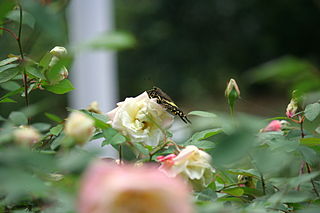
Bambusa is a large genus of clumping bamboos. Most species of Bambusa are rather large, with numerous branches emerging from the nodes, and one or two much larger than the rest. The branches can be as long as 11 m (35 ft).

The clay-colored sparrow or clay-coloured sparrow is a small New World sparrow of North America.

Chimonobambusa is a genus of East Asian bamboo in the grass family. They are native to China, Japan, Vietnam, Myanmar, and the Himalayas.

Dendrocalamus is a tropical Asian genus of giant clumping bamboos in the grass family. It is found in the Indian subcontinent, China, and Southeast Asia.

The Kanapaha Botanical Gardens is a botanical garden in Gainesville, Florida, operated by the North Florida Botanical Society. The name for the garden comes from the nearby 250-acre Lake Kanapaha. "Kanapaha" originating from two Timucua words for "palmetto leaves" and "house". The gardens were established in 1978 when the society leased 33 acres for a public botanical garden. Another 29 acres were added in 1982. The gardens opened to the public in 1986.

Gigantochloa is a tropical Asian and Papuasian genus of giant clumping bamboos in the grass family. It is found in southern China, Southeast Asia, the Indian subcontinent, and New Guinea.

The pale fox is a species of fox found in the band of African Sahel from Senegal in the west to Sudan in the east. It is one of the least studied of all canid species, in part due to its remote habitat and its sandy coat that blends in well with the desert-like terrain. The pale fox is distinguished by its light-colored fur and oversized ears, which enable it to excel in camouflage and survival in harsh environments.

Bambusa vulgaris, common bamboo, is an open-clump type bamboo species. It is native to Bangladesh, India, Sri Lanka, Southeast Asia, and to the province of Yunnan in southern China, but it has been widely cultivated in many other places and has become naturalized in several regions. Among bamboo species, it is one of the largest and most easily recognized.

Potanthus is a large genus of skipper butterflies. They are commonly known as darts. They are found from South Asia to East Asia, and down to maritime Southeast Asia. It includes about 35 species, all of which look very similar to each other and are often only reliably identifiable through the examination of the male genitalia.

The Jardin de l'État, formerly known as the Jardin du Roy, is a historic botanical garden on the island of Réunion, found in the capital Saint-Denis.

Iris pallida, the Dalmatian iris or sweet iris, is a hardy flowering perennial plant of the genus Iris, family Iridaceae. It is native to the Dalmatian coast (Croatia) but widely naturalised elsewhere. It is a member of the subgenus Iris, meaning that it is a bearded iris, and grows from a rhizome. It adapts well to different environments and is used in many different ways.

Bambusa balcooa is a clumping bamboo native from the Indian subcontinent to Indo-China.

Arctostaphylos pallida, commonly known as pallid manzanita, Oakland Hills manzanita, and Alameda manzanita, is an upright manzanita shrub from the Ericaceae, or heath family. It is endemic to the eastern San Francisco Bay Area of Northern California.

The Bambouseraie de Prafrance is a private botanical garden specializing in bamboos, located in Générargues, near Anduze, Gard, Languedoc-Roussillon, France. It is open daily in the warmer months; an admission fee is charged.

Bambusa spinosa, also known as B. blumeana, spiny bamboo or thorny bamboo, although in this respect it may be confused with Bambusa bambos, is a species of clumping bamboo occurring in Tropical Asia.

Bamboo shoots or bamboo sprouts are the edible shoots of many bamboo species including Bambusa vulgaris and Phyllostachys edulis. They are used as vegetables in numerous Asian dishes and broths. They are sold in various processed shapes and are available in fresh, dried, and canned versions.

Bambusa bambos, the giant thorny bamboo, Indian thorny bamboo, spiny bamboo, or thorny bamboo is a species of clumping bamboo native to southern Asia. It is also naturalized in Seychelles, Central America, West Indies, Java, Malaysia, Maluku, and the Philippines.

Bambusa multiplex is a species of bamboo native to China, Nepal, Bangladesh, Bhutan, India, Sri Lanka, Taiwan, and northern Indochina. It is also naturalized in Japan, Iraq, Madagascar, Mauritius, Seychelles, Pakistan, parts of South America, the West Indies, and the southeastern United States.
Bambusa basihirsuta is a species of Bambusa bamboo.
The Itanagar wildlife sanctuary was declared with an aim to conserve the biodiversity around the Itanagar sanctuary. The reserve forest around Itanagar became part of the sanctuary. The sanctuary has geographical boundary limits as River Pam to the east, Pachin in the south, Neorochi on the north-East and Chingke stream in the north. The terrain is mostly hilly. Since the sanctuary is close to the city, it plays an important role in environmental education.



















